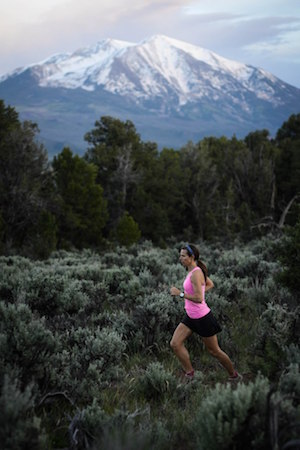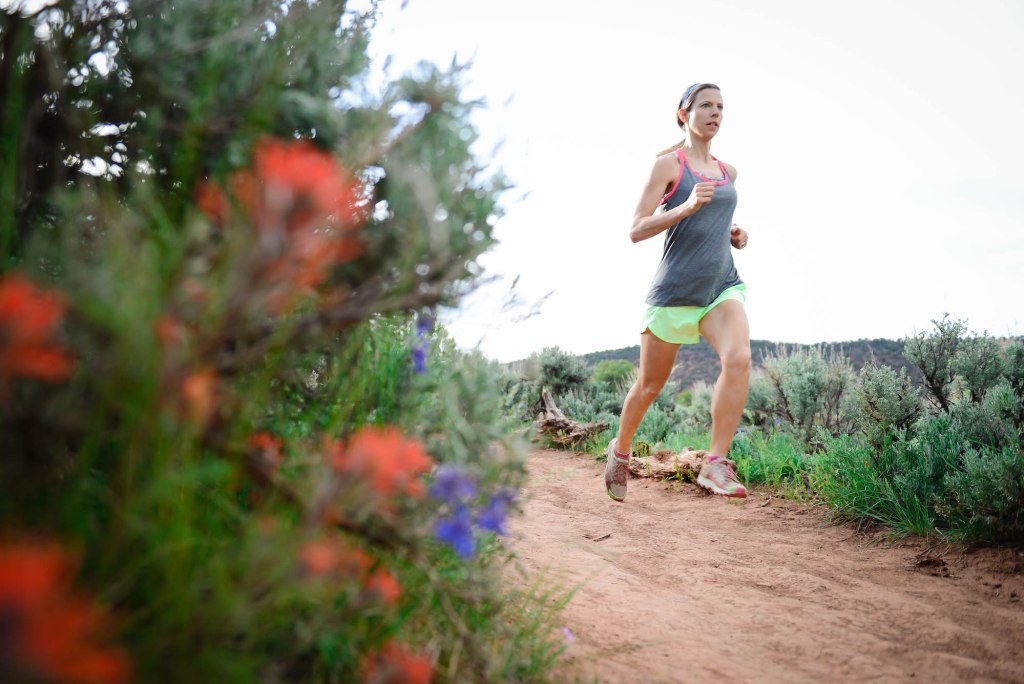Trail running can help you cultivate mindfulness, manage stress both on and off the trails—and in turn enjoy the miles more.
Elinor Fish fell in love with trail running in the Canadian Rockies. After years of running competitively in high school and college, she discovered the freedom of exploring the mountains on her own two feet.
“It was incredibly a relaxing and empowering experience knowing that under my own power, I could take myself to these remote places and explore the wilderness I absolutely loved. That was such a thrill,” she says. She still loved to compete and began racing on the trails.
It was only natural that Fish returned to trail racing not long after starting a family, training for the 2010 Leadville 100 when her son was only a year old. At the time, Fish was also juggling responsibilities as the editor of Trail Runner Magazine with her ultra training.
Running used to fill Fish’s heart but increasingly, it left her feeling more and more depleted and fatigued. She felt like she had to prove herself as a runner and editor of a running magazine who was constantly surrounded by elite athletes. “I felt like I had to do big stuff too. I was pushing myself beyond my capacity in order to fulfill this idea of what I thought people expected of me,” she says.
Even eight months after Leadville, she still felt off and knew something had to change. “The total stress in my life was creating this unsustainable situation where the more I tried to run, the more exhausted I became,” she says.
“I was evolving as an adult and my running needed to evolve with me.”

Photo courtesy of Run Wild Retreats + Wellness
The physical stress of running is only part of the picture. Career, emotional burdens, environmental stress (like seasonal allergies, air pollution and extreme weather conditions) and diet (such as sticking to a strict diet or not getting enough calories to fuel your activity) all cause a similar type of stress response in the body and contribute to your body’s total stress load. Fish learned that she needed to put her training into the context of the rest of her life. “Until we look at how all of these things compile and come together, it’s really hard to bring yourself out of a stress overload situation,” says Fish.
For Fish, that meant becoming clear on the role running played in her life at that moment, which was different than five or ten years ago. “I was evolving as an adult and my running needed to evolve with me,” she says. She began to pay more attention to recovery and sleep. She ate more. She didn’t drive herself so hard at work.
She also started a mindfulness practice, however not one that involved sitting still. Instead, Fish strove to recreate the feeling of freedom and presence she felt on her long trail runs in the Canadian Rockies. It’s become the glue that’s kept together her other healthy habits. It helps her shut off her mind and quiet the voice that constantly whispers that she needs to do more. It’s helped her heal.
Fish realized she could use mindfulness techniques to help other women break free from cycles of injury and burnout and fall in love with running again.
In 2010, Fish began leading women’s trail running retreats through her company Run Wild Retreats + Wellness. Soon, she recognized the same stress and burnout that plagued her in her retreat participants.
“They were going through major life transitions. The retreats were an opportunity for them to heal, emotionally or physically, to reinvest in themselves and to get back in touch with their bodies after years of focusing on their kids’ wellbeing or on their career and ambition,” she says. “I could see it in the comments, feedback and the things that would happen during that retreats that this was about a lot more than just trail running.”
Fish realized she could use mindfulness techniques to help other women break free from cycles of injury and burnout and fall in love with running again. And trails provide the ultimate laboratory, especially for runners who can find it hard to sit still on a meditation cushion.
You have to pay attention. The variation of trail surface and terrain requires a certain degree of mental engagement, even if you’re not scouting every rock and root. While this heightened sense of focus may keep you from tripping, it also makes it easier to stop ruminating on your thoughts, be more present in your body and enter the flow state, where everything feels relaxed, comfortable and easeful.
“Synching movement with breath, focusing your mind on a single point like the trail ahead, maintaining spine alignment to allow energy to flow—these are just some of the ways running creates the coherence in the body that supports present-moment awareness and flow,” says Fish.

Photo courtesy of Run Wild Retreats + Wellness
How to Practice Mindfulness on Your Runs
Fish, now 42, has developed a system to introduce mindfulness to the running experience that she uses during her retreats, which take place in trail running meccas like Moab, Iceland and the Swiss Alps. “It’s for those who are looking for an approach to running that’s more sustainable, fits better into their lives and doesn’t become a huge life stressor,” she says.
Here Fish shares three ways to incorporate mindfulness into your trail runs and develop a healthy running practice that leaves you feeling energized rather than depleted.
1. Find Your Power Posture
“It’s a lot easier for runners to grasp those entry points [to mindfulness] when we’re talking first about what to do with our bodies,” she says. So she focuses on finding a comfortable running posture first: Flex forward from the ankles. Don’t sit back with your hips. Keep your shoulders back and your chest expansive. Not sure you’re doing it right? Have a friend videotape you and implement core exercises and strength training into your routine.
“We start to shift from the analytical mind to the body. I’m putting them in a physical position that makes them more efficient and comfortable as runners,” she says. “My hope is that as they get more comfortable, they relax into the motion of running.” Plus, another reason to work on your posture? It helps you breathe better and feel more confident.
2. Slow Down Your Breath
Slow down and take deeper, fuller breaths on the trails by paying extra attention to your inhales and exhales—and dialing back your pace. “I’ll hear people panting or practically hyperventilating when they approach a hill. We deconstruct how you can approach hills in a way that lets you maintain a more steady, deep breathing pattern so every hill doesn’t become an opportunity to put your body into panic mode,” she says. “This deeper breathing pattern isn’t only more efficient for running but it also helps to trigger the relaxation response.”
3. Set an Intention
It’s tempting to put your brain on autopilot when you hit the trails. Instead, Fish suggests taking a moment before your run to tune into how your body is feeling that day and what it’s telling you. “Maybe you planned one kind of run but you feel heavy and tired,” she says.
Ask yourself how you want your run to make you feel. Maybe you set out to hit a certain speed, but you’re still sore from yesterday. Instead, shift to a recovery run and focus on a pace that feels comfortable. “Don’t worry about running seven miles or running a certain pace or doing a specific number of intervals. That may be the content which you’ll use to fulfill that intention,” says Fish. “Set an intention that is going to make that run the most beneficial for you on that particular day. This is part of the process of changing our focus from outcomes to process.”
You can use these same mindful running techniques to deactivate your stress triggers and shut off your stress response in your everyday life you so you don’t fall into a habitual stress-anxiety loop. “Whether we’re facing a crisis in our lives or we’re facing a big hill on the trail, the body responds in the same way,” says Fish. “That’s why I think having these tools in our toolbox as runners is important. If we realize that this can help us during these other life moments, too, we’re better off.”
